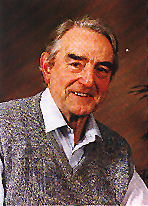OBITUARY
ERNEST TOMLINSON MBE 1924 – 2015

The doyen of British Light Music composers
Obituary by Tim Reynish July 6 2015
Some fifty five years ago, one of my first jobs as a freelance horn player was guesting with the then BBC Welsh Orchestra, which was primarily a small light orchestra playing programmes of popular British light music for Breakfast Special with the occasional light classical programme. It was great training; since everyone knew the repertoire, nobody wanted to rehearse, and any new player would be expected to sightread ten or twelve new pieces faultlessly in a 3 ½ hour recording session.
I remember my biggest solo was If you want to know the time ask a policeman, but my favorite work of all was a Suite of English Dances by Ernest Tomlinson, six wonderful movements attractively scored, a light music classic. When I began to develop the Novello wind band catalogue, I immediately invited Ernest to re-score them for wind band, and over twenty years later he did so. The source for the tunes is the source which Kenneth Hesketh also uses in Danseries, Playford’s Dancing Master, every movement is based on immediately attractive tunes, brilliantly transcribed for wind band, a terrific piece for players and audience.

Ernest Tomlinson was undoubtedly the leading English composer of light music of the past fifty years, and in addition worked tirelessly on behalf of his fellow composers and musicians in a variety of administrative posts. He studied at Manchester University and the Royal Manchester College of Music, and after war service he worked in London and later back in Lancashire as a conductor, composer and arranger, writing a considerable body of works ranging from incidental music for radio, television and the theatre, to overtures, suites and rhapsodies and miniatures, as well as concertos, opera, ballet and works for choirs, brass and wind bands.
A man of boundless energy, Ernest Tomlinson also found time to serve for several years on the Executive Committee of the Composers' Guild of Great Britain and was its Chairman in 1964; in addition, he was a composer-director of the Performing Rights Society since 1965. In recent years he has housed the Library of Light Orchestral Music. The library has grown and now contains an astonishing 35,000 pieces of music, donated by composers and libraries throughout the country. Ernest himself made a number of recordings of this great British musical heritage for the label Marco Polo.
He has contributed to both wind and brass band repertoire, but his main achievements have been in the fields of light music. The time is long overdue for assessing his contribution to wind band repertoire, but it includes a dazzling Divertimento for wind dectet, Fantasia on Auld Lang Syne and his outstanding Suite of English Dances
Jenny Pluck Pears
Ten Pound Lass
Dick’s Maggot
Nonesuch
Hunt the Squirrel
Woodicock
January 1950, and a full house at the Royal Albert Hall, London, for the New Year Festival of Folk-Dance, promoted by the English Folk-Dance and Song Society. Towards the end of the first half, following folk-dances from various parts of Britain, the lights slowly faded, leaving the hall almost in darkness. The audience hushed and there came a haunting melody on solo violin; the dim lighting revealed three gracefully dancing couples dressed in the attire of the 1600s. This was the old English dance Jenny Pluck Pears withaccompaniment provided by just two violins. For one young composer it was magic The young composer in question was, of course, Ernest Tomlinson who, together with his wife Jean, had been invited to the event by his sister Freda, a keen folk-dancer. From that experience came the composer's resolve to express some of those lovely tunes through the medium of full orchestra.
The treasure-trove from which the English folk-dances were selected was the first edition (1650), of John Playford's The English Dancing Master. Here were set down the steps of the most popular dances of the day, together with the melodies used. As The Dancing Master, this book, with additions and changes, was reissued in various editions until 1728. Four of the Playford tunes, regretfully discarded at the time, had to wait another 25 years or so, before being incorporated into Tomlinson's Second Suite of English Folk-Dances. The folk-dances being short, they were offered for broadcasting in pairs and accepted for performance by the London Light Concert Orchestra under Michael Krein. Jenny Pluck Pears and Ten Pound Lass were completed first and broadcast in September 1951. Then came the fifth and sixth movements, broadcast in January 1952. The fourth movement, Nonesuch, was then completed readily enough, which left Dick's Maggot. Once Dick's Maggot was completed the way was now clear for a complete performance of the suite, which was given by Michael Krein and the London Light Concert Orchestra in August 1952. Dedicated to his sister, it has since become one of the most performed suites.